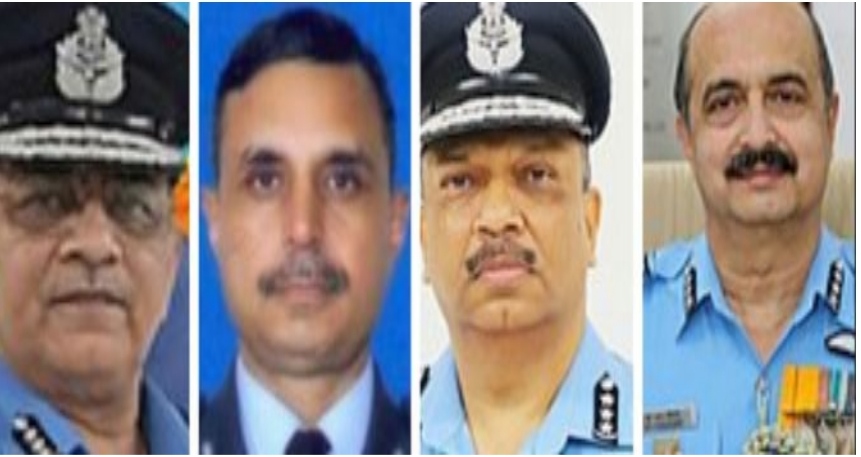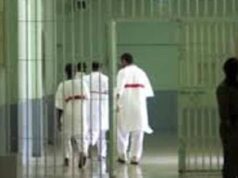Time for the CCA to name the new IAF and NAVY Chief’s

(From left to right) Air Marshal Amit Dev, Air Marshal Manavendra Singh, Air Marshal Sandeep Singh, and Air Marshal Vivek Ram Chaudhari
The race has begun. With the Chief of Defence Staff as Ex Officio Secretary Department of Military Affairs initiating the process of selection of the next Air Force and Navy chiefs.
Earlier the government declared the name of the succeeding chief around two to three months before the superannuation of the current chief. This not only stopped all politics if any in its tracks but also provided sufficient time to the new Incoming incumbent to understand and coordinate with the Outgoing chief for the continuation of the work.
Though the announcement of appointment of ACM Bhadauria had come just ten days before his retirement—he was due to retire on September 30, 2019, along with the then Air Force chief, Air Chief Marshal B.S. Dhanoa. The elevation to the post of gave ACM Bhadauria avoided any supersession and also gave him two more years in service.
The corridors of South Block in the Lutyen are abuzz with names of contenders. Soon, the ministry of defence will send four names to the appointment committee of the cabinet.
Names of four senior-most air marshals for the top post have already been shortlisted. The Chief of Indian Air Force Air Chief Marshal RKS Bhadauria is set to retire on 30 Sep 21.
Air Marshal Vivek Ram Chaudhari, Air Marshal Amit Dev, Air Marshal Manavendra Singh and Air Marshal Sandeep Singh are in the race to succeed Air Chief Marshal (ACM) Bhadauria.
Air Marshal Chaudhari, presently the vice chief of IAF, is the senior-most officer in the race. Commissioned in the fighter stream of the IAF on December 29, 1982, Air Marshal Chaudhari has a flying experience of more than 3,800 hours on a wide variety of fighter and trainer aircraft, including missions flown during Operation Meghdoot and Operation Safed Sagar.
Operation Meghdoot was the code name for the Indian Armed Forces’ operation to seize control of the Siachen Glacier in Kashmir in 1984, and Operation Safed Sagar was for IAF’s role in the 1999 Kargil conflict.
Next in line is Air Marshal Amit Dev, who is the Air Officer Commanding-in-Chief of Shillong- based Eastern Air Command. As a fighter pilot, he has flying experience of over 2,500 hours on a variety of fighter aircraft including MiG-21 and MiG-27. Over the course of a vast career of 38 years, he has commanded a fighter aircraft squadron, air defense direction centre and an operational fighter base.
The Chief of Thiruvananthapuram-based Southern Air Command, Air Marshal Manavendra Singh is a helicopter pilot, with over 6,600 hours of flying experience in various sectors like the Siachen, the Northeast, Uttarakhand, and the western desert.
Air Marshal Sandeep Singh, the junior most is heading the Jodhpur-based South Western Air Command can also be considered for the top post. In his long career of 37 years, he has commanded a fighter aircraft squadron and was a project test pilot for the Su-30MKI. Due to his proficient knowledge of the Su-30MKI platform, Air Marshal Sandeep Singh has been the mainstay liaison for the implementation of various weapons and systems by DRDO. He has served as the Deputy Chief of the Air Staff as well.
The government will also have to decide on the next chief of the Indian Navy. Incumbent Chief of Naval Staff Admiral Karambir Singh is completing his tenure in November. Admiral Karambir Singh took over the reins of the Indian Navy as the 24th chief in May 2019, becoming the first helicopter pilot to helm the force.
Coming to the Navy, like it had happened with ACM Bhaduria, the senior-most naval officer after chief of naval staff is retiring on the same date. Vice Admiral Anil Kumar Chawla, who is heading the Southern Naval Command, is due to retire on November 30, the same day when Admiral Karambir Singh is completing his tenure.
A navigation and direction specialist, Vice Admiral Chawla commanded Coast Guard Ship C-01, Vidyut class missile boat INS Vinash, Kora-class guided missile corvette INS Kora, Stealth frigate Tabar and the aircraft carrier Viraat in his service of close to four decades. Since IAF has a ‘precedence’ of an officer being appointed as the chief on the day of his retirement, the Navy may also be expecting the same.
But commanding the Southern Naval Command, which is not an operational command, takes away the advantage. Instead, his juniors have been allocated operational command. Traditionally, Naval officers who commanded the operational command like Eastern or Western Commands are the preferred lot.
Then comes Vice Admiral R. Hari Kumar, who heads the Mumbai-based Western Naval Command. He is specialised in gunnery and has commanded five ships, including a Destroyer and the aircraft carrier INS Viraat. He has held important staff appointments both ashore and afloat and has also been Naval Advisor to the Government of Seychelles.
Vice Admiral Ajendra Bahadur Singh, chief of the Vizag-based Eastern Naval Command, is the third senior-most officer to be in the race for the top post.
Naval officers believe that the actual race is between Vice Admiral Chawla and Vice Admiral Hari Kumar.
The ‘seniority principle’, which is used to be the convention for selection of chiefs in the three services, is no longer the sole criterion followed by the Centre, especially after the selection of General Bipin Rawat as the Army chief, ignoring two seniors over him, and Admiral Karambir Singh as Navy Chief over Vice Admiral Bimal Verma.
However giving a go bye to the ‘seniority principle’ is very dangerous. At the level of the C-in-C post, all have proved themselves and are equal. To a non military person it will be very difficult to make any appraisal regarding their military abilities. Hence unless someone proves otherwise with some actions of his (secret or public) the best guarantee against the politicisation of top appointments is to go by Seniority.
Moreover, in the military, the line of succession has always been clear, as the prospective candidate is groomed to become the chief. Most countries in the world do follow the seniority principle though at time there are exceptions. Military powers the United States, France and Germany, are such examples.
Iandn China the overriding principle is the Loyalty to the Communist Party and its Supreme Leader. In Pakistan It is the whim and fancy of the Prime Minister because this is the only time when he can take his own decision provided the outgoing Chief does not interfere. However, the UK still follows the practice seniority very seriously.



